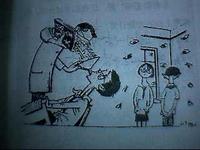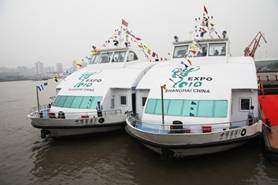1. What is the curriculum like for Chinese school?
In elementary school, the curriculum is fixed. Students must study literature, math, English, music, art and physical education. Although these subjects are mandatory, the curriculum depends on the individual teacher and school. In junior high, further subjects are required study: history, geography, and one of politics, chemistry, biology or physics. The reason for this addition in high school is that students must sit for a standardised exam to enrol into their choice of university of college.
Like much of the rest of the world, a university degree or college diploma is becoming the “bare minimum” for any sort of white collar position. Because of China’s large population, the number of students is proportionately large as well. The 1999 census from the China Statistical Yearbook pegs the number of students in the entire school system at 290,000,000 (yes, two-hundred-and-ninety-MILLION). The nationwide census was just conducted last year, but I would suspect the figure now to be vastly greater than that.
Given the numbers, I’m sure you can appreciate that university entrance exams are a big deal in China. Students are under great pressure to get into a good university. Testing is standardised across the nation and students will be tested on literature, math, English and one of either history, geography, political science, chemistry, biology or physics, depending on their discipline. I’ve noticed that everybody speaks with empathy and pity when they talk about the fierce competition that students must face during these entrance exams.
Because the exams take place all at once, students must sit for the exams in a classroom or auditorium. Here’s what it usually looks like:

And here’s a picture of some students in Beijing after their exams:

2. How long is the duration of their education?
At the national level, the Ministry of Education stipulates a mandatory 9-year period of public schooling called “义务教育” (yì wù jiào yù), where tuition is free, but textbooks and materials are not. Depending on the region, mandatory public schooling starts when a child is either six or seven years old and enters primary school. Preschool is private and up to the prerogative of the parents.
After the mandatory public schooling period, students are allowed to make a decision to either pursue secondary education (senior high school) or wrap up their education commitments and enter the workforce.
At senior high, a student must also begin to plan whether to ultimately pursue undergraduate or vocational studies.
So much like abroad, the typical student that completes higher education will finish at about the age of 22 or so, depending on their education choices.
3. Where do they go for lunch? What do they have? Do they have lunch at school canteen? If yes, what do they eat? If not, where do they go?
China is vast, and whilst some schools have canteens that are operated by third parties within the school, poorer schools might elect to have food prepared on the outside and brought to the students. In either case, safety is a concern and the responsibility of the school, so children are not allowed to leave the school grounds.
Here’s a couple of pictures of what a typical canteen looks like:


Food choice is limited, and you basically eat what everybody else eats. It’s mostly traditional Chinese fare, with rice, vegetables and meat. Milk or some beverage is usually provided. Although lunch isn’t explicitly covered in the mandatory public schooling programme, for the most part it will be subsidised.
Much like other countries, students are given more freedom beginning in senior high and university. They can either choose to eat outside, or at the canteen.
4. What extra-curricular activities they can do during lunch or after school?
Sports and special interest groups are usually what students might partake in. Younger children might choose anything from badminton or basketball to dance, singing, or even dance.
Time for play decreases though, as students get older, and are under higher pressure to get into a good university. Getting into a good university means getting into a good high school; which means getting into a good junior high; and which also means, of course, getting into a good elementary school and preschool.
Because of this widespread competition, it’s very common to see young children begin afterschool tutoring at a young age. It’s an all too familiar tragedy to see parents picking up children after school and ferrying them to their next tutoring class. And that’s all on top of the homework they have to do!
5. Do they wear a uniform? If yes, what does it consists of?
All students, regardless of public or private school, will wear uniforms up until high school. Those in the mandatory public school system will have uniforms that are standardised throughout their city. Usually different uniforms are assigned depending on the season. Here’s one type of uniform:

And another PE type which is also quite commonly seen:

6. What sports do they do in Physical Education?
Although students are required to take P.E., the curriculum itself varies widely and is usually done so at the discretion of the P.E. teacher and the school.
Common activities include things like volleyball, basketball, track and field, and swimming. The availability of each event is usually limited by the facilities at the school. Schools without swimming pools, for example, might organize a school bus for all the students to visit a local swimming pool. Interestingly, things like gymnastics and football are not as prevalent. Mostly this is because of lack of facilities.
I’m told that in some senior high schools, students might be given the choice of learning things like yoga, or tai chi, albeit at a beginner level.
7. What are the school hours?
School hours are from 8am to 4:30pm or 5:30pm, depending on the geographical region and season, with about an hour for lunch.
Much like overseas, university life is significantly more independent and hours are based on specific classes. Just like when I went to university in Canada, the university students here will try to stack all classes as close together as possible to get more days off.
8. What school trips do they go on?
Day trips are organised each year, and are pretty much the same things you might do at your school. Everything from parks, to museums, art galleries and the science centre will usually be organised by the school.
9. How often do they get homework?
Like we’ve talked about before, academic competition in China is high because of the large population. Students will begin getting homework as soon as they begin elementary school at the age of seven. The amount of homework will be about one to two hours a day.
This sounds gruelling for a child to have to do so much homework so early on, and I agree. I will say though that the average parent in mainland China is thoroughly more intimate with their child’s school life than overseas parents. Unlike abroad, parents are expected to take an active role in their children’s homework and supervise their children’s progress. In fact, parents must sign off on a time sheet each day to show that their child has completed the homework! Can you imagine having your parents supervise your homework every day in primary school? I’m not sure your parents could, either. 🙂
Fortunately for students, university is more lax, and students are given more latitude when it comes to arranging their own study habits.
10. What is the school’s behaviour code? (Eg,Sent out of class,Letter to parents)
From what I can tell, much of it is quite similar to what we have abroad. What can and can’t be done is very common sense, and the types of reprimand a teacher can issue are limited to the same sort of things that you may face in Scotland.
Competition for higher education is fierce, so the onus to perform well academically is the student’s and their parent’s responsibility. This forms a natural conformity because it’s in the child’s best interest to do well in school. Uncooperative students and parents will simply find themselves unable to catch up in the competitive academic environment.
In university there is far less control from the school, and whether a student passes or fails or even shows up to class is at the student’s discretion.
11. How involved do the kids get in the lessons?
There’s a common criticism regarding the education system in China. It’s known as “填鸭式教育” (tián yā shì jiào yù, or “force-fed education”). It focuses on a top-down approach to teaching, and students learn by rote and repetitive practice. Critics both home and abroad realise the deficiencies of this regimented approach: communication is one-directional and feedback from students is limited. Check out this editorial cartoon from Chinese media that criticises “force-fed education,” the student has no recourse but to accept the information that’s being poured down his throat:

There are practical reasons for this strategy though; it would be unfair to simply conclude that all educators are stuffy conservatives without vision. Although this system neglects creativity and innovation, one must remember that China has a very large population and this top-down approach is still the most effective way to ensure equitable opportunity and set a wider baseline for impoverished regions to follow. Without set teaching guidelines, students from poorer regions would be hard pressed to compete academically with their cosmopolitan counterparts.
This approach also spills over in the workplace with the new graduates that I see. My personal observations in the office is that while local students are well practised at mimicking and reproducing actions once you show them, upwards feedback and innovation are severely lacking.
Thanks for the questions; there’s more to come so stay tuned!











































